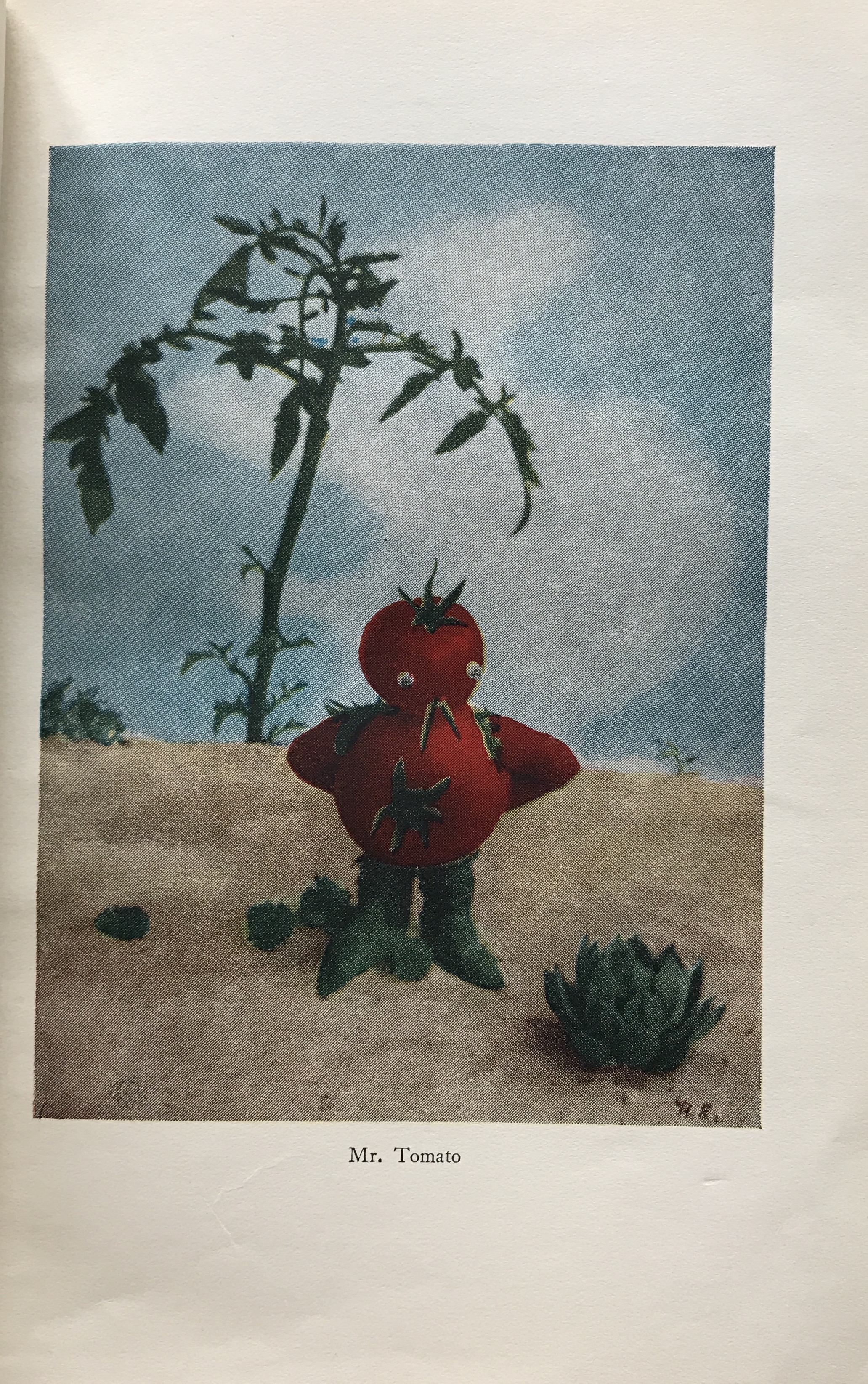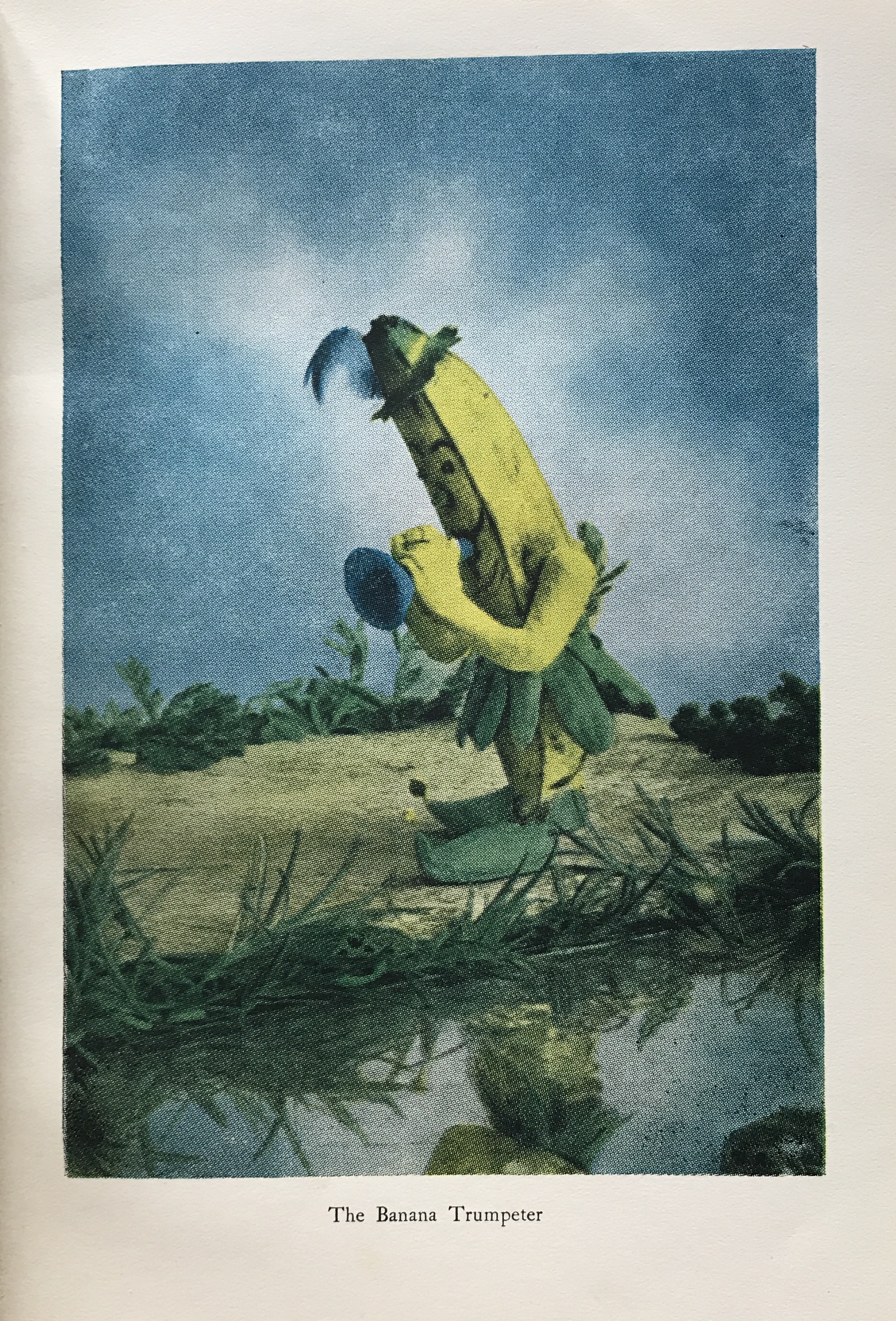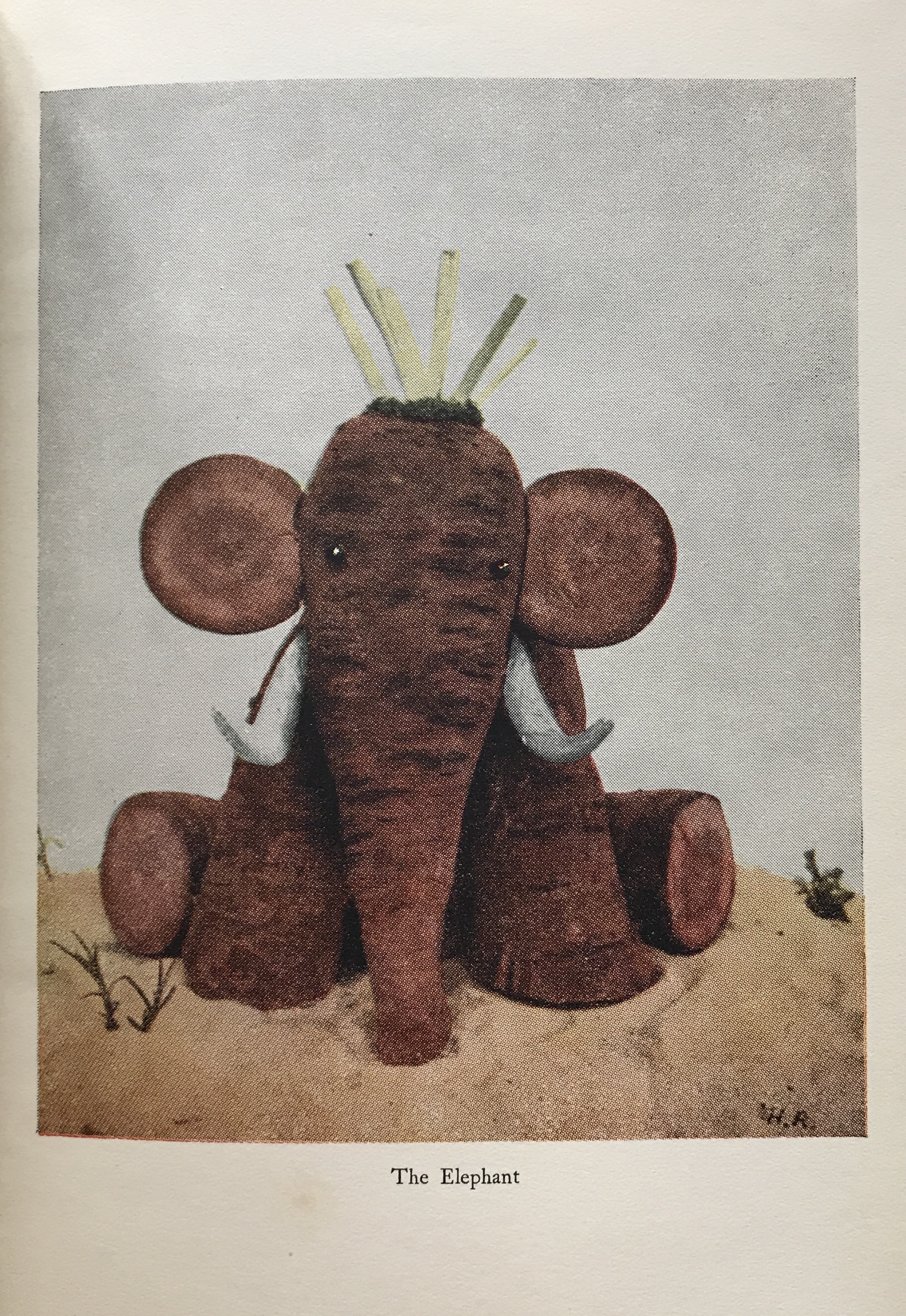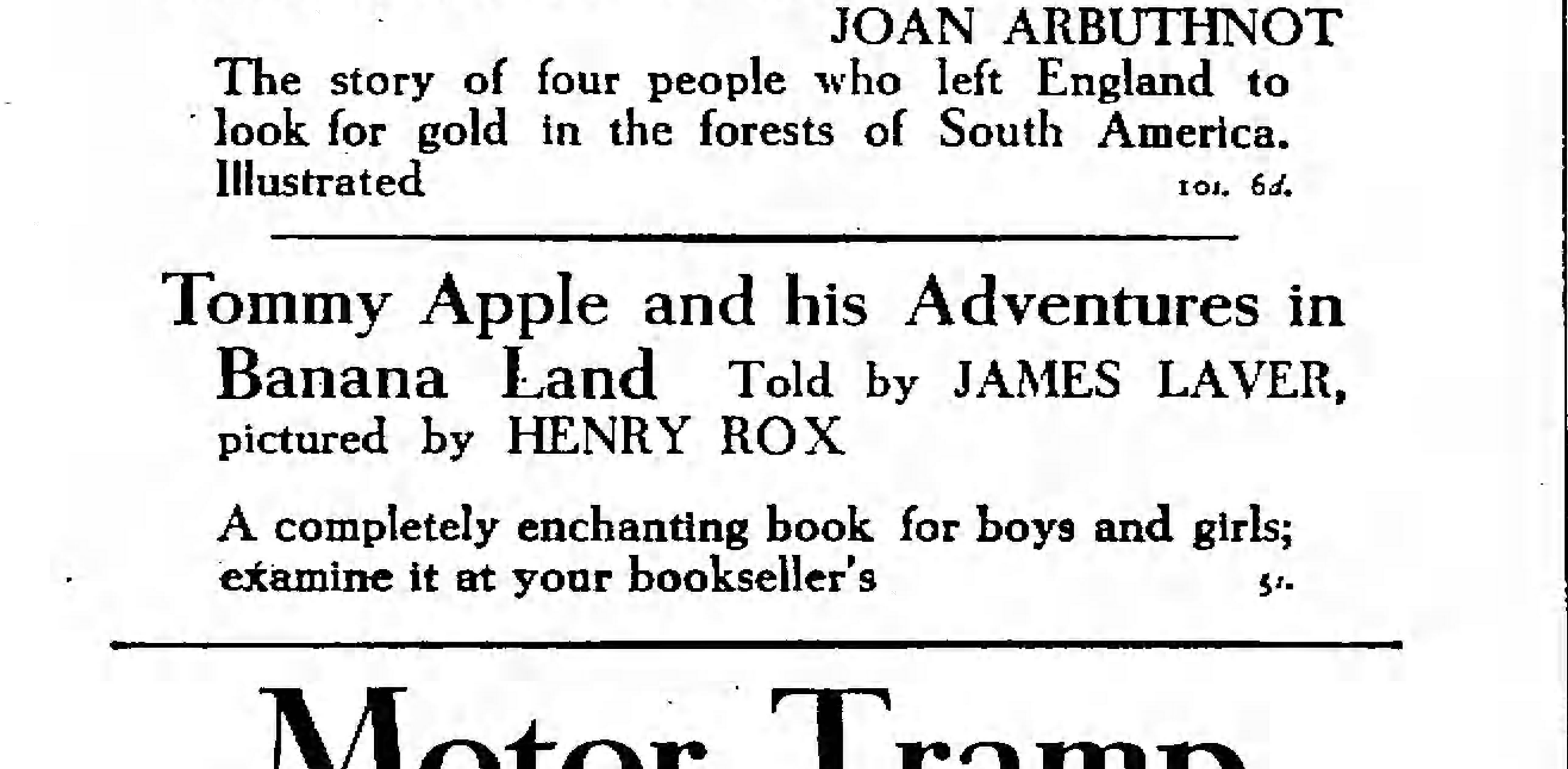Archive
https://archive.metromod.net/viewer.p/69/1470/object/5140-11267243
Archive
Tommy Apple and his Adventures in Banana-Land
- Book
- Tommy Apple and his Adventures in Banana-Land
Word Count: 7
- Henry RoxJames Laver
- 1935
- 1935
Jonathan Cape Publishing House, 30 Bedford Square, Fitzrovia, London WC1.
- English
- London (GB)
The children’s book Tommy Apple and his Adventures in Banana-Land with staged photographs by the émigré Henry Rox shows anthromorphised fruit and vegetables that think, speak and act like humans.
Word Count: 31

John Laver (text), and Henry Rox (pictures). Tommy Apple and his Adventures in Banana-Land. Jonathan Cape, 1935, cover (METROMOD Archive). 
John Laver (text), and Henry Rox (pictures). Tommy Apple and his Adventures in Banana-Land. Jonathan Cape, 1935, title page (METROMOD Archive). 
Henry Rox, Mr. Tomato, in Tommy Apple and his Adventures in Banana-Land. Jonathan Cape, 1935 (METROMOD Archive). 
Henry Rox, Lady Leek, in Tommy Apple and his Adventures in Banana-Land. Jonathan Cape, 1935 (METROMOD Archive). 
Henry Rox, The Banana Trumpeter, in Tommy Apple and his Adventures in Banana-Land. Jonathan Cape, 1935 (METROMOD Archive). 
Henry Rox, King Orange, in Tommy Apple and his Adventures in Banana-Land. Jonathan Cape, 1935 (METROMOD Archive). 
Henry Rox, Every day Tommy went fishing, in Tommy Apple and his Adventures in Banana-Land. Jonathan Cape, 1935 (METROMOD Archive). 
Henry Rox, The Elephant, in Tommy Apple and his Adventures in Banana-Land. Jonathan Cape, 1935 (METROMOD Archive). 
Advertisement for Tommy Apple and his Adventures in Banana-Land by James Laver and Henry Rox in The Observer, 17 November 1935, p. 6 (Photo: Private Archive). 
Advertisement for Tommy Apple and Peggy Pear by James Laver and Henry Rox in The Manchester Guardian, 27 November 1936, p. 7 (Photo: Private Archive). 
Article on Henry Rox’s contribution to the film Strike Up the Band (1940) in Abbeville Progress, 12 October 1940, p. 2 (Photo: Private Archive). Anonymous. “He Makes Humans Out of Vegetables.” The Brooklyn Eagle, 14 July 1940, p. 40.
Exhibition of German-Jewish Artists’ Work: Painting – Sculpture – Architecture, exh. cat. Parsons Galleries, London, 1934.
Fisher, Margaret (text), and Henry Rox (pictures). Banana Circus. G.P. Putman’s Sons, 1940.
Howard, Michael Spencer. Jonathan Cape, Publisher: Herbert Jonathan Cape, G. Wren Howard. Jonathan Cape, 1971.
Laver, John (text), and Henry Rox (pictures). Tommy Apple and his Adventures in Banana-Land. Jonathan Cape, 1935.
Laver, John (text), and Henry Rox (pictures). Tommy Apple and Peggy Pear. Jonathan Cape, 1936.
Scheffler, Karl [K. Sch.]. “Kunstausstellungen.” Kunst und Künstler. Illustrierte Monatsschrift für Kunst und Kunstgewerbe, vol. 30, 1931, pp. 148–152.
Scheffler, Karl [K. Sch.]. “Lebendige deutsche Kunst.” Kunst und Künstler. Illustrierte Monatsschrift für Kunst und Kunstgewerbe, vol. 32, 1933, pp. 102–103.
Vollmer, Wolfgang. “Henry Rox Revue. Annäherungen an ein fotografisches Werk und eine biografische Skizze / Approaches to a photographic oeuvre and biographical sketch.” Idem. Henry Rox Revue. Fotografie / Photography 1935–1955, Fotohof edition, 2020, n.p.
Word Count: 154
Mount Holyoke College, South Hadley, Archives & Special Collections, Henry Rox Papers.
Word Count: 12
- London
- Burcu Dogramaci. "Tommy Apple and his Adventures in Banana-Land." METROMOD Archive, 2021, https://archive.metromod.net/viewer.p/69/1470/object/5140-11267243, last modified: 20-06-2021.
-
Exhibition of German Jewish Artists’ Work: Painting – Sculpture – ArchitectureExhibitionLondon
The Exhibition of German Jewish Artists’ Work was organised in 1934 by Carl Braunschweig at the Parsons Galleries in Oxford Street and featured 220 works by German Jewish artists.
Word Count: 27
Henry RoxPhotographerSculptorNew YorkHenry Rox was a German émigré sculptor and photographer who, in 1938, arrived in New York with his wife, the journalist and art historian Lotte Rox (née Charlotte Fleck), after an initial exile in London. Besides his work as a sculptor, he began creating humorous anthropomorphised fruit and vegetable photographs.
Word Count: 50
Gerty SimonPhotographerLondonThe Berlin photographer Gerty Simon established a studio in Chelsea, London. Her solo exhibition Camera Portraits from 1935 featured a distinctive portrait of the émigré art dealer Alfred Flechtheim (shown above).
Word Count: 30